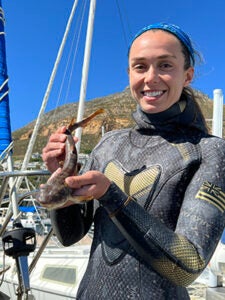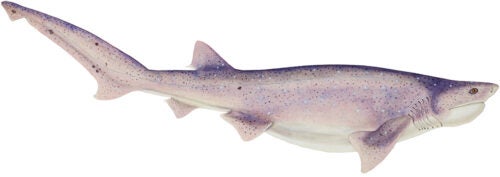By Tony LaRoche
Growing up on Ryder’s Cove in Chatham, Massachusetts, Christine de Silva, M.S. ’23, was a big fan of the Discovery Channel’s Shark Week. For one, her birthday fell during the annual all-shark festival, plus there were the sharks.
 “Shark Week is such a great chance for people to get a view into something the vast majority of people have little to no experience around,” said de Silva, who graduated last spring from the University of Rhode Island’s Blue MBA program with master degrees in business administration and oceanography. “They get to see people interacting with animals that we’ve been taught are terrifying, and yet we see the same people coming back every year. So obviously that isn’t the case.”
“Shark Week is such a great chance for people to get a view into something the vast majority of people have little to no experience around,” said de Silva, who graduated last spring from the University of Rhode Island’s Blue MBA program with master degrees in business administration and oceanography. “They get to see people interacting with animals that we’ve been taught are terrifying, and yet we see the same people coming back every year. So obviously that isn’t the case.”
This past July, Shark Week celebrated its 35th season, and de Silva appeared in her third episode since 2020. A research assistant on previous shows about tiger sharks and great whites, de Silva, chief executive officer for the ocean technology company Juice Robotics, served as co-host and photographer for the 2023 season’s “Alien Sharks: Strange New Worlds.”
In February, she joined host and wildlife conservationist Forrest Galante and the crew for a month to film the show, tooling around the waters off South Africa in search of the strangest sharks they could find. High on their list was the sevengill.
“Most sharks have five gills. The more prehistoric types will have six or seven gills,” said de Silva, who lives in Jamestown and is now pursuing a Ph.D. in oceanography at GSO. “In False Bay, South Africa, the sevengills are typically found in kelp forests and get very large, about 10 feet. They can take down seals—they are sharks—but they’re thought to be pretty docile.”
 But the sevengill sharks were nowhere to be found. Two orcas—killer whale brothers named Port and Starboard by locals—were wreaking havoc, de Silva said. They had killed scores of great whites—actually flipping the whites over on their backs to dine on their livers—off South Africa, especially around Cape Town, known for its cage diving with great whites. Eventually, the more-
But the sevengill sharks were nowhere to be found. Two orcas—killer whale brothers named Port and Starboard by locals—were wreaking havoc, de Silva said. They had killed scores of great whites—actually flipping the whites over on their backs to dine on their livers—off South Africa, especially around Cape Town, known for its cage diving with great whites. Eventually, the more-
transient animals smartly moved on, leaving the orcas to feast on sevengills, which can’t migrate to safety like great whites.
“When we were there, there were a couple of days when about two dozen sevengills washed up dead with their livers missing, proving they were killed by Port and Starboard,” she said. “Those are just the ones that washed up.”
While the sevengills aren’t transient, they seem to have disappeared. But many people in the area thought they must be somewhere in False Bay, south of Cape Town. So, the Shark Week crew went looking. They found about 15 of the sharks in a harbor, under a shipwreck. “The sharks were hiding from the orcas in the dark, in about 15 feet of water with the worst visibility,” she said. “I couldn’t see my fins when we were diving. It was crazy. We were swimming through them, bumping them.”
But filming the sharks mostly meant deploying her cameras—Baited Remote Underwater Video (BRUV), which were developed and supplied by Juice Robotics—at depths up to 1,000 meters, then coming back in six hours, hoping for a bite.
“The cameras were not attached to the boat so we were unable to see what we were filming in real time,” she said. “St. Lucia is a popular sport fishing area. So, we’d go out early in the morning, drop the cameras and go fishing. We’d catch dinner, take a nap, pick the cameras up and then, over beers and dinner, watch the footage and see what we got.” What they found were numerous shark species in the deep seas around Cape Town and St. Lucia that have seldom been seen before, or not seen at those depths, in those areas.
“Deep-sea animals in general are often very dark colored so they can hide better,” she said. “They often have really big eyes that seem to glow green when you flash light at them. You also get a lot of really slow-moving sharks. While there is food down there, there’s less food. So, they act very chill to conserve energy until all of a sudden they have to use that energy to go after prey or, if they’re lucky, scavenge.”
Along with the fun of filming sharks, de Silva, who does research for the nonprofit Beneath the Waves, collected data on such things as abundance, diversity and behavior, and plans to publish her findings. Also, through her work with Juice Robotics, her role in Shark Week helps her promote her view of ocean research, which includes innovative, democratic, rugged equipment like the BRUVs that are easy to transport and deploy.
“For me, Shark Week is such a great chance to represent the future of what I hope ocean science looks like,” she said. “I really was excited to do my first episode because I not only got to do the science, but I got to educate a large audience.”
